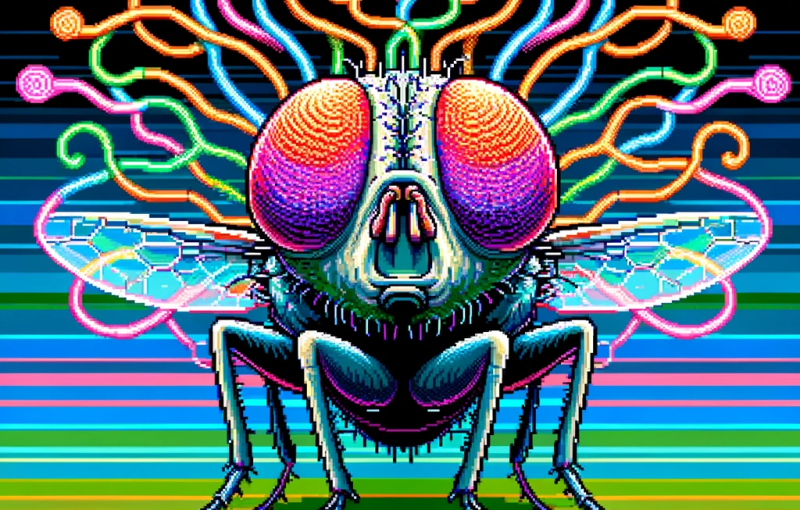
Flies’ Eyes! and Motion Detection
by Jon Scaccia February 6, 2024When I make my list of the top ten bugs, fruit flies are not on it. Not even close, for reasons you might guess. That doesn’t mean they’re not fascinating.
A recent breakthrough, “How Flies See Motion,” published in the Annual Review of Neuroscience. This article delves into the intricate motion detection mechanisms, particularly in the fruit fly Drosophila, revealing a complex yet elegantly organized neural process.
The Puzzle of Motion Detection
Imagine sitting in an IMAX theater, engulfed in panoramic scenes. Though stationary, you feel a sense of movement – a testament to our brain’s motion vision capability. This phenomenon isn’t exclusive to humans; it’s crucial for survival in many species, including the humble fruit fly. Motion detection helps navigate environments, avoid predators, and even mating rituals. But how do these tiny creatures process such complex visual information?
Decoding Motion: The Fruit Fly’s Visual System
The Building Blocks of Vision
At the heart of the fruit fly’s vision are its compound eyes, each consisting of about 750 facets. Beneath these facets lie photoreceptors, which convert light into electrical signals. These photoreceptors, named R1 to R8, form the foundation of the fly’s motion detection mechanism.
The Intricacies of Motion Processing
The signals from these photoreceptors travel to the fly’s brain, where they undergo intricate processing. Researchers have identified key steps in this journey:
- Signal Comparison: To detect motion, the brain compares signals from adjacent photoreceptors over time.
- Temporal Delays: For an object moving in a specific direction, there’s a sequence to how these receptors are activated. The brain detects this sequence through temporal delays in the signals.
- Nonlinear Interaction: Simple addition of these signals isn’t enough. The fly’s brain employs a nonlinear interaction – think of it as a complex mathematical operation to discern motion direction.
Models of Motion Detection
The study of motion detection in flies has led to several models, each trying to explain how these insects process visual information:
- Exner’s Model (1894): Suggests that signals from adjacent image points spread in opposite directions.
- Hassenstein–Reichardt Detector: A more sophisticated model involving linear filters and multiplication to register signal coincidence.
- Barlow & Levick’s Model: Proposes mechanisms like ‘preferred direction excitation’ and ‘null direction inhibition’.
The Neural Circuitry of Motion Detection
The Role of T4 and T5 Cells
Central to the fly’s motion detection are two types of neurons: T4 and T5 cells. These cells are responsible for processing directional motion. They come in various subtypes, each tuned to a specific direction of movement. The intricate connection of these cells with other neurons in the fly’s brain forms the basis of its exceptional motion detection ability.
The ON and OFF Pathways
The fly’s visual system splits the visual information into two pathways: the ON pathway, which deals with increases in light, and the OFF pathway, which handles decreases in light. This division is crucial for accurately processing motion.
The Bigger Picture: Implications and Applications
Understanding how fruit flies detect motion can have far-reaching implications. It can enhance our knowledge of neural processing in other organisms, including humans. Moreover, this research can influence the development of artificial vision systems, improving technologies like autonomous vehicles and robotic vision.
Conclusion
The study of motion detection in fruit flies provides a window into the complex yet efficient ways nature processes information. This research advances our understanding of neural circuits and inspires technological innovations, demonstrating the profound impact of studying even the smallest creatures.
Take Action
To delve deeper into this fascinating world of neural computation and visual systems, explore the full article: “How Flies See Motion.” It’s a journey through one of nature’s most intricate and elegantly designed systems.
Leave a Reply